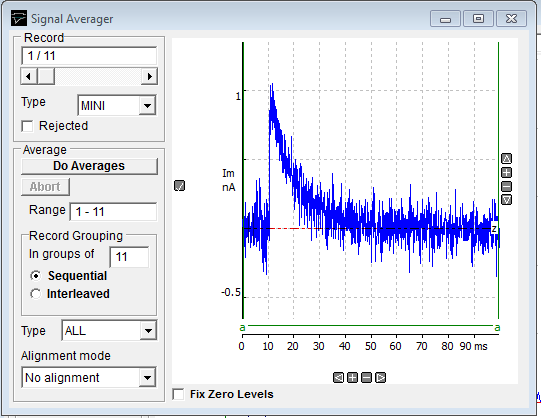Signal Averaging > Creating Signal Averages
Select
AnalysisSignal Averaging
to open the signal averaging window.

To create a series of signal averages:
1) Specify the range of records to be averaged by entering the first and last records, separated by a “-“, in the Range box.
2) Select the Sequential option to average sequential groups of records (i,i+1,i+2...i+n-1) or Interleaved to average sets of records interleaved together (i,i+n,i+2n,..). Enter the number of records (n) in a sequential or interleaving group in the in groups of box.
3) You can restrict averaging to a specific type of record by selecting a type from the Type list. Select ALL to use records of any type (except rejected records).
4) Set the alignment mode. Select No alignment if the position of the signals do not vary within the records and alignment is not necessary. If alignment is necessary, select on positive rise for positive-going signals and on negative rise for negative signals.
5) Set the alignment search region cursors. If records contain stimulus artefacts, it may be necessary to restrict the region of the record which is searched for the signal mid-point, in order to avoid the averages being aligned using the artefacts rather than the true signals. The alignment search region is set by moving the two vertical cursors on the display to define the beginning and end of the region containing the signal.
6) To create the averages, click
Do Averages
The averaging process now proceeds. An additional digitised data file is created containing the average record(s), with the same name as the original data file, but with a ".AVG" file extension rather than ".WCP". On completion of averaging, the record display module is opened to show the average records.
You can switch the display back and forth between the averages file and the raw data file by selecting
View
Averaged Records
To view the averages, and
View
Raw Records
To view the original digitised signal records.